Garages often serve as multi-purpose spaces, accommodating vehicles, storage, and even workshop areas. When it comes to finishing the interior of a garage, proper drywall installation is essential for a polished and functional look.
While hanging drywall on the walls is relatively straightforward, many homeowners may be unsure how to finish the bottom edge of the drywall panels in their garage.
In this comprehensive guide, we will walk you through the step-by-step process of finishing the bottom of the drywall in your garage.
From ensuring a clean and even cut to applying the appropriate finishing techniques, we’ll cover everything you need to know to achieve a professional and aesthetically pleasing result.
How to Finish Bottom of Drywall in Garage?
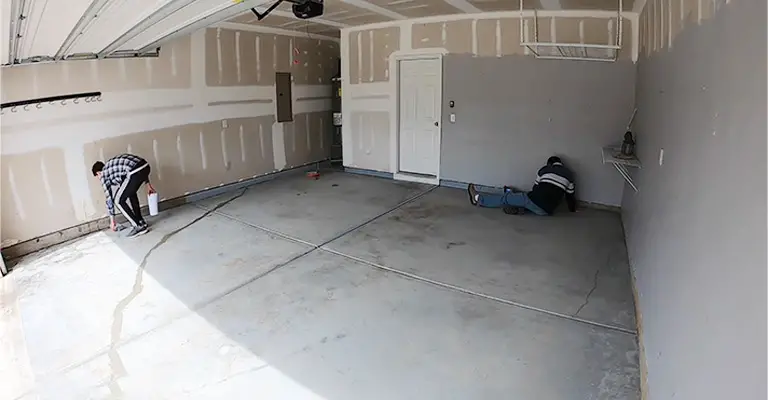
When the bottom of the drywall is finished, a garage can be transformed with significant advantages.
Furthermore, the garage provides a comfortable, temperate environment for working year-round for the homeowner. The following instructions describe how to finish the garage drywall’s bottom.
Tools Needed
Before you begin finishing the garage drywall, gather the required tools: stainless steel knife, tape measure, corner trowel, and a drywall mud pan.
The following materials will also be needed: sandpaper in various grouts, joint compound, mesh drywall tape, and a pole sander.
1. Maintain A Gap
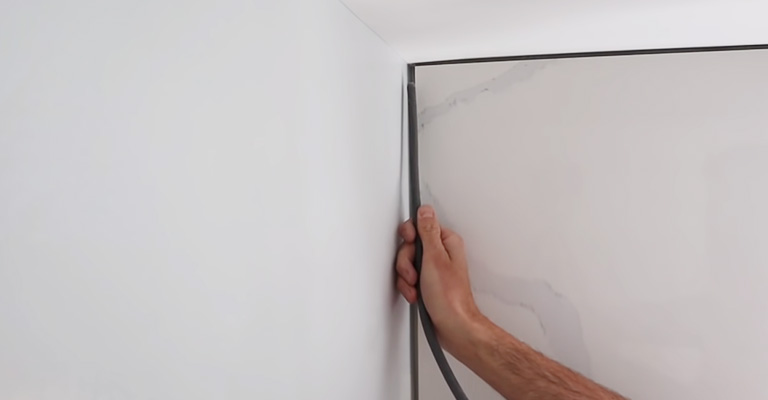
The drywall bottom is finished after the installation of the upper portion of the drywall in the garage.
If you are finishing the wall, you should maintain a 1/2-inch or 5/8-inch gap between the drywall and the floor.
There should be a gap to keep moisture on the garage floor from getting into the absorbent drywall and forming mold.
Due to their uneven floors, there are also significant gaps between the drywall sheets in concrete garages. In some cases, cracks in drywall can be caused by floor expansion during weather changes.
2. Fill In Gaps Between Drywall Sheets
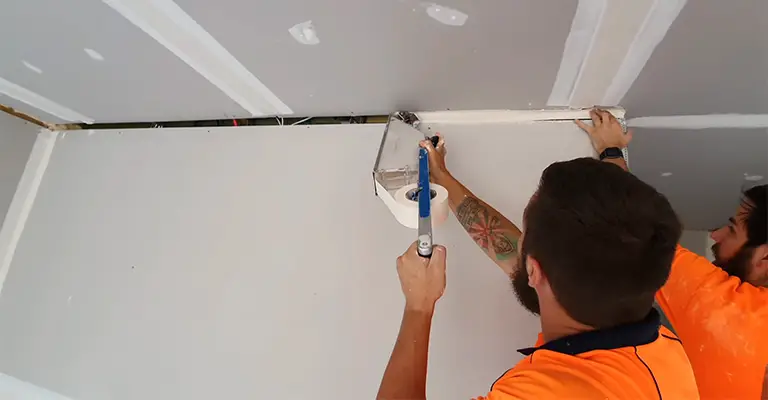
If the gap is larger than 1/4 inch, mesh tape must also be used in addition to the joint compound. Insert joint compound into the gaps and along the gaps through the holes in the mesh tape.
It is only through the mesh tape that the compound will be set properly. Once it has dried overnight, sand it.
3. Add Mud Over Drywall Screws
Paint two coats of drywall mud over the screws. The edges of the screws will be visible through the mud if they are not flush against the wall.
Make sure the screw is covered with joint compound using a drywall knife. Ensure that the compound has time to dry.
4. Tape The Seams
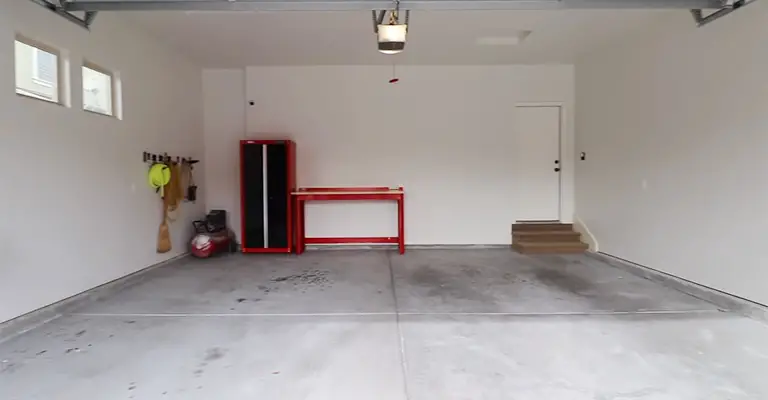
There is something to be said for flat walls over bumpy ones. When drywall sheets are fitted together, flat joints are produced, or butt joints are assembled. The two are often mixed together.
Make sure the drywall mud is smoothed out at the edges. When edges are smooth, less sanding is required later on. Dry the joints once they have been taped and mudded.
You should cut out bubbles that appear along the drywall underneath the drywall tape with a utility knife if they appear.
Similarly, you can fill the cutout space with the compound as you would any other hole or gap. Ensure there is sufficient drywall mud underneath the tape.
5. Sand And Skim Coat
Upon drying drywall mud, sand the wall so it appears smooth. Applying a skim coat prior to priming and painting makes the drywall’s surface consistent for painting.
6. Gather Supplies For Priming And Painting

A 3/4-inch paint roller is required to prime and paint the drywall with latex primer and latex paint in the desired wall color.
Plastic sheeting, old towels, or painter’s tarps can prevent overspray. It is optional to apply Homax water-based drywall spray texture.
7. Add Texture
Industry professionals prefer the Homax spray texture because it can provide light or heavy textures. Make sure to cover the floor with a tarp or plastic sheet to avoid overspray.
Using a texture brush, apply texture to the wall taking care not to overspray so as to blend the texture in with your existing walls.
8. Apply Primer
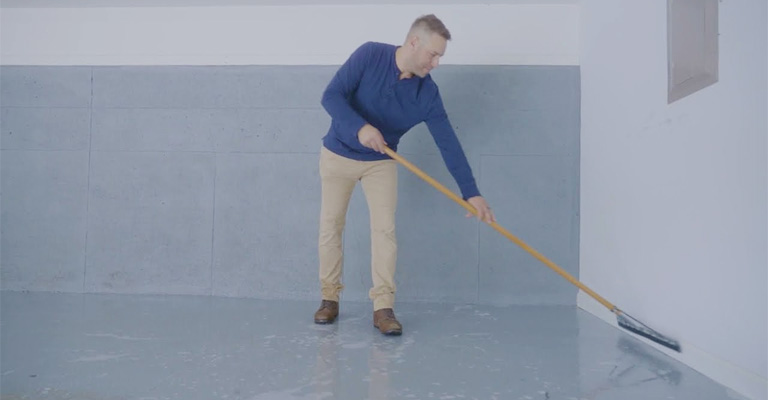
Following the dryness of the texture, a primer coat can be applied. We recommend using a multi-purpose water-based primer for walls.
Apply an oil-based primer to oil-based paint and a water-based primer to water-based paint. After one hour, the primer becomes touchable; however, give it three hours to dry completely.
9. Paint The Garage Drywall
When painting garage drywall, choose interior paint (exterior paint is not recommended). In addition, industry experts recommend satin-finish paint.
Ensure that your paint finish is even by applying two coats. Be sure to let the first coat dry completely before applying the next.
What Are The Benefits Of Drywalling The Garage?
The temperature in the garage can be regulated by adding drywall over the insulation. It prevents frozen pipes in colder areas by keeping the internal temperature above freezing.
A drywall wall keeps hot air outdoors in warmer locations. Garages are not only comfortable, but they have other benefits as well. Electrical outlets are easier to install in a garage that has been drywalled.
For electrical outlets in an unfinished garage with concrete walls, breaking through a portion of the wall is necessary, and running wires through concrete walls is difficult.
A dry-walled garage allows you to easily add electrical outlets and hide wires. Several outlets in the garage serve as outlets for power tools and other equipment.
Finishing the garage can increase a home’s sale price by thousands of dollars by adding additional workspace.
Why Do I Need to Protect the Bottom of My Drywall?
In any case, why does drywall have to be protected or finished? The drywall should protect the garage, isn’t it?
For sheathing walls in the garage, drywall makes the area more fireproof and is the most affordable, accessible material to use.
As a result, drywall is also poorly resistant to impact. Furthermore, it has a very high moisture absorption capacity.
If you want to prevent drywall damage or rot, you must prevent water from entering the cavity. Waterproofing the drywall is, therefore, essential for completing the drywall properly. To accomplish this, there are several ways.
Baseboards or Garage Floor Trim?
Typically, it’s best to finish the bottom of your drywall with a combination of trim, such as baseboards or wainscotting, and waterproofing.
You can buy garage floor trim in a few different materials, including vinyl and rubber. It is unlikely that baseboards can protect all of the drywall from high flood levels due to their low height-the largest are about 6″ tall.
It is therefore recommended to waterproof in conjunction with this. Aesthetically pleasing but not necessarily the most valuable or practical choice.
Metal or Rubber Strip?
For a garage, leaving an opening between the finished floor and the drywall is generally practiced. Typically, this gap measures ½ inches to 2 inches in height.
Attaching an L-shaped strip here is advisable to help prevent rot, mold spores, and more from occurring.
Hardware stores carry these strips in water-resistant materials like metal, rubber, and vinyl. You can blend the strip into the drywall by applying Joint compound, also known as drywall mud.
Waterproof Primer
In addition, you can use a waterproof primer to finish and protect the bottom of your drywall. Home improvement or hardware stores have plenty of brands and options available to choose from.
Paint above the waterproofing layer so that water won’t rise above it as it pools on your garage floor. The primer typically only requires a coat or two to treat your drywall, so you only need one container.
You should undoubtedly take the size of your space into account when determining the size of your area.
How Do You Waterproof The Bottom Of A Garage?
Flooding is a risk in your area, or heavy rain can cause damage to your garage, so waterproofing is a wise decision. If you want to waterproof the bottom of your garage, waterproof paint or epoxy are the easiest options.
Essentially, you are only required to apply paint or epoxy directly onto the waterproof area.
After you have done that, let it sit for a few days to dry and cure. Alternatively, a waterproof membrane can be used on the concrete slab when building your garage to prevent moisture from leaking.
Do I Need To Finish Drywall In The Garage?
Compared to the drywall within your garage, drywall inside your home is typically prepped and finished more thoroughly. The reason for this might be that, in part, you live in your home, not in the garage.
To keep your home cozy, you should ensure there is nothing that could enter it. Furthermore, it looks better when it has been correctly finished! Finishing your garage drywall is not required, but it will look better if you do.
How Do You Finish The Inside Of A Garage Wall?
There are multiple ways you can finish the inside of your garage wall. In terms of effectiveness and commonness, drywall is the most popular.
Using it can help to increase a wall’s fire resistance. It is easy to install and can be done quickly.
In case you do not want to use drywall, you can use a method called oriental strand board, or OSB. No taping or finishing is required because this can simply be screwed to your wall framing!
Should I Put Baseboard In The Garage?
It’s essential to understand what the purpose of a baseboard is in your garage before you decide to install one. Typically, baseboards are used to protect the drywall from water damage or foreign invasions like pests.
In addition to that, it provides another layer of protection. The use of this method can be very beneficial in areas like your garage, where moisture is more likely to build up.
The Bottom Line
If you own a garage, it may be your haven, the place where you can do some work, relax, and perhaps do some cleaning. When the space is only being used for storage, you still want to ensure it is protected from moisture and insects.
In addition to damaging your tools, automobile, and garage structure, they can even weaken its structure. Here are some ideas for finishing your drywall so that your garage is protected and in good condition.
Even though you can finish drywall yourself, it can be somewhat daunting unless you have some experience behind you. A drywall repair professional can help you with your garage drywalls when you need reliable work done.







